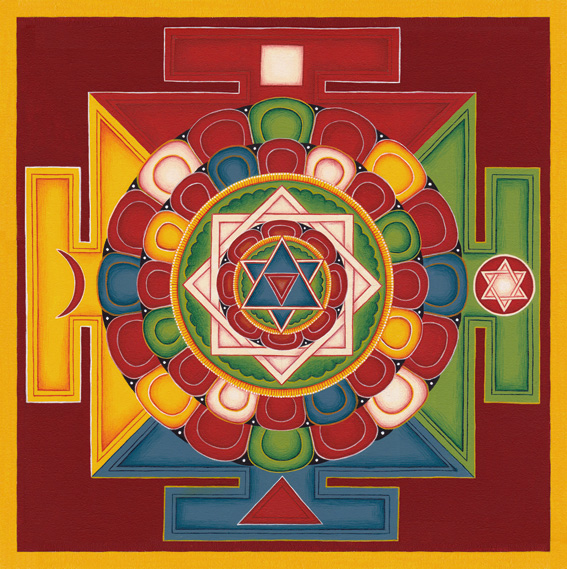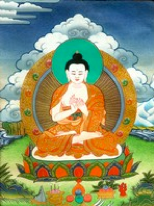Buddhist Psychology: What Are the Five Buddha Families?

Many methods exist for cultivating the energies of our mind to higher levels of awareness. One of the most illuminating is that of the ‘Five Buddha Families’ which is an ancient Buddhist system of categorizing and blending aspects of the mind in order to understand the mind, and to work with this knowledge.
At the recent 10 day meditation retreat I attended I wrote about in this post: My First 10 Day Buddhist Samatha-Vipassana Meditation Retreat in NYC
we got to learn and practice a lot of new techniques and learn some things about Tibetan Buddhism. I had never been particularly drawn to Tibetan Buddhism with all it’s esoteric symbolism that meant, well, I had no idea. But what I learned not only fascinated me but empowered me to work with my mind in ever more intricate and beautiful ways. Really taking this particular presentation of the human mind energies to heart and putting it into practice can be one of the most transformational things you could ever do for yourself and the way to you respond to the world, relinquish karmic reactions and live as your highest expression.
The five buddha families enlightens us by bringing together the perplexing mix of higher mind faculties and the lower base ego centered proclivities. If people or even yourself sometimes bewilder you I think you will find this very interesting.
The buddha families present a “mandala” (from the Sanskrit for “circle”) called the five tathagatas, or buddhas. This wheel of information assists one in contemplation to create a framework of how contrasting aspects of our psychology orchestrate to form a symphony. Each of the five buddhas that exist in the mandala expresses one of five different facets of enlightenment. However, these expressions are not only as enlightened states but also as neurotic patterns of mind. What we find is that these are ultimately the same mind. What makes a difference is traversing the pathways to awakening.
Because the lords of the five Buddha-families beautifully exemplify the powers and aspects of the enlightened state toward which we're aspiring, an understanding of them helps us to see how our main human faults contain within them the core of what we can become in our fullness. ~ KHENCHEN THRANGU RINPOCHE
Five Wisdom Families

Through the purification of the five consciousnesses one also purifies the five mental afflictions known as the kleshas, and thus the five types of primordial awareness gently but increasingly reveal themselves to us.
I previously about this wrote in this series Meditation and Buddhism - What is Compassion? about lower energies, the kleshas, we have inside us that we need to transform on our journey on the path to awakening.
The method to transform afflictions into wisdom is by applying the appropriate perfections which, when combined with the underlying energy, turns the frozen energy into its corresponding wisdom.
This means that when we are experiencing Fear, Anger, or Frustration, we remind ourselves that Intelligence underlies these afflictions. We then apply patience while continuing to penetrate and analyze the situation we are experiencing. Analysis of the causes and conditions, combined with patience, then provides us with the clear seeing that was the original message behind our Fear or Anger.
http://www.chinabuddhismencyclopedia.com
So, what I am going to do over the next few essays is really explore each family, explain the mandala structure and how we can take this information as a whole as we study and eventually each of it’s parts and how we can then apply them to ourselves and reach higher levels of consciousness. Thus, we will eventually get to a place where all our responses have been transmuted into pure enjoyment. I don’t know about you but that sounds good to me.

Five Buddha Families
The five Buddha families form the base of a mandala structure that are:
• Buddha Family – “Consciousness”
• Vajra Family – “Form”
• Ratna Family – “Feelings”
• Padma Family – “Perceptions”
• Karma Family – “Intention”
This will become clear as we go down each one. The head of each family is a meditation aid called a “dhyana Buddha” or a meditation Buddha and they correspond to a type of energy that we saw in the Buddha Families list above are as introduction they are:
- Vairochana – “One Who Completely Manifests”
- Akshobhya - “Unshakeable One”
- Ratnasambhava – “Source of Preciousness”
- Amitabha – “Infinite Light”
- Amoghasiddhi – “One Who Accomplishes What is Meaningful”
If we look up at the base mandala family list that starts with “Buddha Family” each of these has a head of the family, the head Buddha, also sometimes called a “lord”. So, the first head Buddha or lord of the Buddha Family is Vairochana.
The First Buddha Head – Vairochana

Vairochana is considered the depiction of the true nature all things and the fundamental nature of mind. One description is:
The first of the Five Buddha Families.
He sits upon a throne that represents the true nature of things. The throne is composed of a lotus and full-moon disk and is upheld by eight snow lions. The snow lions represents the complete realization of the true nature of the aggregate of form, the realization of wisdom that clears away all confusion to unveil the true nature of ignorance. The lotus and full-moon disk represent the skillful means and primordial wisdom that conquer confusion and overcome the deluded mind, enabling one to turn away from non-meritorious actions toward beneficial practice. The color of the deity is white, unsustained by confusion. His right hand holds the Wheel of Dharma, symbol of the constant disclosure of the teachings, his left hand holds a bell, symbol of the gentle manner, kindness, and compassion with which he turns the Wheel of dharma. ~ The Five Buddha Families, by Khenpo Karthar Rinpoche.
Let’s break this down:
- Represents the true nature of all things
- Snow lions represent the realization of wisdom, that clears away all confusion to unveil the true nature of ignorance and complete realization of the true nature of aggregate of form
- The lotus and full moon disk represent skillful means and primordial wisdom that conquer wisdom and overcome the deluded mind enabling one to turn away from non-meritorious actions and toward beneficial practice.
- The color of the deity is white – NO CONFUSION
- His right hand holds the Wheel of Dharma, symbol of the constant disclosure of the teachings
- His left hand holds a bell, symbol of the gentle manner, kindness, and compassion with which he turns the Wheel of dharma
So, as we see in this graphic depiction of the Five Buddha Families in the center is Vairochana, lord of the Buddha Family. He is white and represents the wisdom of all-encompassing space, the true nature of things also thought of as emptiness and its opposite, the fundamental ignorance that is the cause samsara, the cyclic existence caused by karmic actions rooted in ignorance. The opaqueness of ignorance transforms to a vastness that is space accommodating anything and everything.
So, how do we use this as practical knowledge?
Vairochana represents the perfect transmutation of all the base energies to their higher counterparts thus all ignorance to wisdom. The other lords pertain to more specific afflictions such as desire, anger and the enlightened activities that they take on our behalf as we meditate on them for our release from suffering caused by ignorance and kleshas and the expressions of the energies manifesting in their purified state.
So, what we are doing in working with the Five Families is gradually changing our view from form and feeling to acting with awareness and intention and that this becomes our primary focus. Stopping our everyday reactions that arise out of the karmic patterns we have developed and changing the kleshas to their flip side which are wisdoms.
I hope you join me so we can move through the imagery and meaning of the rest of the Lords in the Five Buddha Families and transform our consciousness.
What do you think?
Buddhas imagery: http://www.namsebangdzo.com and http://asc-sg.org
Special thanks for art work at top: "Mandala of the Five Elements" by Carmen Mensink, used with permission of the artist
Recent posts
Awaken Your Creativity/Writing With Morning Pages and Buddhist Mindfulness Practices
My First 10 Day Buddhist Samatha-Vipassana Meditation Retreat in NYC

@soulsistashakti is a musical artist and writer based in NYC as well as a practitioner of Buddhist teachings. You can check out my music on my FB artist page at https://www.facebook.com/soulsistashakti
Check out my blog for other essays on Buddhism and meditation
Wow! somehow I missed the previous post on your retreat so I'm going to go back and read that one and then read this one. I'm very interested in what you experienced and how that is changing you. Thanks for putting this up. Blessings.
Of course and please let me know how it resonates or any questions you have, as always. xx